

Glitch Art Resources. This is a collection of resources I find relevant to my own creative practice concerning Glitch Art.
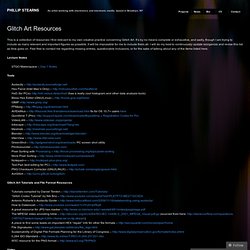
It’s by no means complete or exhaustive, and sadly, though I am trying to include as many relevant and important figures as possible, it will be impossible for me to include them all. I will do my best to continuously update reorganize and revise this list as time goes on. Feel free to contact me regarding missing entries, questionable inclusions, or for the sake of talking about any of the items listed here.
Lecture Notes STGO Makerspace – Day 1 Notes Tools Glitch Art Tutorials and File Format Resources Video Theory / Writings (Glitch and Related Media Art Topics) Criticism Cathryn Ploehn “Not So GIFted” – Community Stuff Artists (Glitch and Related): Code: PDF for complex 3D output. Complex 3D output using PDF in Processing.
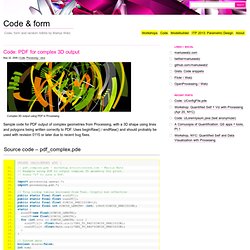
Sample code for PDF output of complex geometries from Processing, with a 3D shape using lines and polygons being written correctly to PDF. Uses beginRaw() / endRaw() and should probably be used with revision 0115 or later due to recent bug fixes. Source code – pdf_complex.pde. Ga2003_paper. Gallery of Computation. LIVING WORKS binary.ring bit.10001 bone.piles box.fitting box.fitting.img new bubble.chamber buddhabrot city.traveler cubic.attractor deep.lorenz guts new happy.place new henon.phase henon.phase.deep new inter.aggregate new inter.momentary new invader.fractal limb.sand.stroke limb.strat limb.stroke mcp moonlight.soyuz nine.block node.garden new offspring orbitals new paths.i peter.de.jong sand.dollar sand.stroke sand.traveler new self-dividing.line stitches substrate new tree.garden.ii trema.disk trema.spike INFORMATION about the programmer about the medium ORDERING works available production qualities ordering policies.
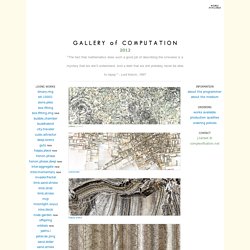
Jerome Saint-Clair (01010101) Reza Ali. C++, code art, GUI, Inspiration, iOS, iPad, ofxUI, open source, OpenFrameWorks, OpenGL, Special Effects, Technology, UI Design, User Interface Algorithmic, Art, C++, code art, Computational Design, Design, Generative, GLSL, Graphic Design, Gray Scott, Inspiration, ofxUI, OpenFrameWorks, OpenGL, Prototyping, Reaction Diffusion, Reza, Simulation, Visualization, Visuals.
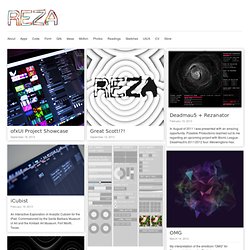
Marius watz: unlekker.net. Processing. Processing. Processing class art. Computing for the Arts with Processing. Workshops. Are you an artist looking to explore digital media? Are you a web developer wanting to learn new skills, and new tools? Classrooms. Processing and Arduino in Tandem: Creating Your Own Digital Art Tools, projBox Kit - Training. Training > Processing and Arduino in Tandem Instructor: Joseph Gray This course is an online course in partnership with creativeLIVE This Online Training Course Has ConcludedThe sessions were presented live during August and September, 2010.
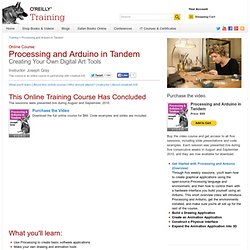
Groups. Artefact. Teaching. Daniel Shiffman is a Assistant Arts Professor at ITP (Interactive Telecommunications Program).
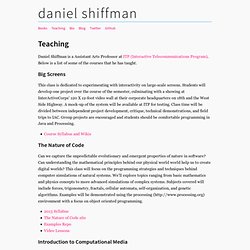
Below is a list of some of the courses that he has taught. Big Screens. Processing 101. Processing is an open source programming language and integrated development environment for artists.

It’s used by artists to create art, visualizations and simulations. This course serves as an introduction to programming in processing. Focus is on the application than theory. Tools for Teaching. The making of 'Four Letter Words' by Rob Seward (@robseward) #Arduino #Processing #c++ About a year ago, Rob Seward created the Four Letter Words piece.
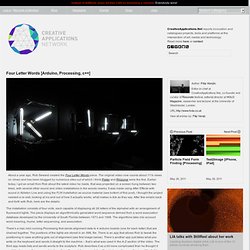
The original video now counts about 111k views on vimeo and has been blogged by numerous sites out of which I think Pieter and Rhizome were the first. Prototyp-0 / Font Generator by Yannick Mathey (@bytefoundry) #processing #typography #font. Created by Yannick Mathey (byte-foundry), prototyp-0 is an application designed for the drawing of typographical characters.

Created using Processing, the application automates the process allowing you to manipulate a large number of character properties in realtime, reflecting on the results and applying it to others. Settings used on a single letter or letter sequence “type,” are instantly reflected on all the glyphs: Low-to-break, capitals, small capitals, but also numbers and common punctuation. The built in database includes all the typographic features achievable for any desired font, including fonts similar to the historical styles. Markers can alert the user of the limits and within the established rules of proportion and typography. 'Silenc' at CIID - Visualisation of silent letters in a language / #Processing. This project by Manas Karambelkar, Momo Miyazaki and Kenneth A.
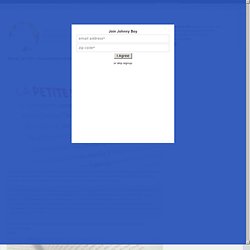
Robertsen at the CIID explores how much of a language is silent. ‘Silenc’ is a visualization of an interpretation of silent letters within Danish, English and French languages done by eliminating or highlighting the silent letters within a prescribed text. One of the hardest parts about language learning is pronunciation; the less phonetic the alphabet, the harder it is to correctly say the words. A common peculiarity amongst many Western languages is the silent letter. A silent letter is a letter that appears in a particular word, but does not correspond to any sound in the word’s pronunciation.
Capturing the dynamism and diversity of the MIT Media Lab - New identity by @TheGreenEyl #Processing. In 2010 MIT Media Lab approached TheGreenEyl and E Roon Kang to update their identity for the lab’s 25th anniversary. Previous identity components were designed in 1984 by Jaqueline Casey, but there never was an actual logo per se. The team developed an algorithmic logo using Processing (founded by Ben Fry and Casey Reas in 2001 while at the MIT Media Lab) in an effort to capture the dynamism and diversity of the MIT Media Lab. Mycelium [Processing] - Fungal hyphae growth using images as food //app by @notlion. Mycelium is a simulation of fungal hyphae growth using images as food, created by Ryan Alexander.
The project originally started in 2005 while he was working at Logan in Venice, California. Click images to see full size. Hyphae grow into the lighter areas of the image while avoiding their own trails. Branching and growth speed are also functions of the avalible food (brightness) in the image. Type can be added by splitting the trails up into phrase-sized chunks of different colors. Created with Processing. 'Generative Photography' by Ishac Bertran (@ishacbertran) #Processing. In the last few weeks Ishac Bertran has been making experiments in the area of “Generative Photography”. He describes the process where the digital drawings are sequentially projected on to a screen in a dark room and photographed using long exposure times. “from 0 to C” - Teaching programming using a more tangible approach / by @codetroubles. Created by Ubi de Feo, “from 0 to C” is a series of workshops that aim to teach programming using a tangible approach.
Learning how to program requires pragmatic thinking and “advanced problem solving” and through the use of tangible, hand-made objects, the team behind the project try to establish a clear understanding of how a computer works and what a programming language actually is. With the increase of interest in coding, trying to sometimes teach programming to designers can indeed be a challenging task. The Digital Rube Goldberg Processor - by The Product and HfG Karlsruhe communication design students. #processing. Kinect Physics Tutorial for Processing. The Abyss by @andreasgysin [Tutorial] - Graphics, animation and interaction with #Processing.
Learning Processing: A Beginner's Guide to Programming Images, Animation, and Interaction by Daniel Shiffman. Journey - coffeemakescreative. VOID, An iPad Mag That Aims To Teach The Art Of Coding. The visual programming language Processing is one of the coolest design tools out there, and I write about it all the time.
But have I learned the language myself? No: because I have yet to stumble across the perfect "onboarding" experience, something that makes me forget about how difficult learning to program seems, while still building up the necessary "101-level" skills. Creating a Particle System in Processing: Beginning with Particle Animation — CMD-c && CMD-v. I have recently decided to take on the task of creating a particle system from scratch designed to work specifically with Processing . I have always been interested in the subject and I wanted to challenge myself and share something with the Processing community.
I am going to write this series of articles to document my learning process as well as the evolution of this library. For this first article, I am going to start with the most basic concepts of dealing with particles in Processing. No differential equations, no numerical methods, just simple linear algebra and Java. Openlab Workshops » Processing Course for Beginners. Processing for Visual Artists. Processing Class. OpenProcessing - Share your sketches! Objects.